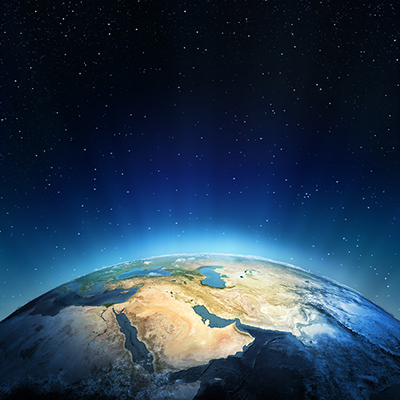
Negative stories about the Middle East dominated Western news headlines in 2015. It’s easy for Americans, especially those who listen to Republican presidential candidate Donald Trump and his supporters, to get the impression that the region is just one miserable homogeneous place of violence, terror, religious fanaticism and authoritarianism.
What is missing in these portrayals is the fact that in an area of the world with 350 million individuals spread across nearly 25 countries, there is not one story. In fact, there are positive events everywhere. This year, people fell in love, made music, opened community centers, launched successful businesses, celebrated graduations, births and weddings, won international competitions in math and sports, and much more. The dominant US media’s focus on the worst of the news doesn’t do justice to the rich complexity of life across this vast region.
It is true that 2015 was a rough year in some areas of the Middle East. ISIS claimed the lives of many in Syria and Iraq, including Muslims and Christians. So did state violence in Syria, Saudi Arabia, Egypt and Israel-Palestine. Ongoing wars and economic desperation, sometimes fueled by devastating climate change, drove hundreds of thousands of refugees to risk their lives traveling to Europe. Rocketing inflation made life difficult in Sudan, Egypt and Yemen. Government clampdowns on democracy occurred in Turkey and Egypt. At times it can be hard to believe that almost five years have passed since promising citizen-led uprisings swept across the region, aiming to improve the lives of the people who live there.
Unfortunately, though, the deluge of bad news has hardened erroneous views of a Middle East perennially in conflict. Such views not only prevent Americans from understanding that the region is as vibrant and variegated as any in the world. They can also then translate into support for such abhorrent ideas as banning all Muslims from the United States or rejecting Syrian refugees fleeing ISIS.
Just like in the Americas, in the Middle East this year there have been many positives as well as negatives, advances as well as setbacks. Recognizing more of the complexities and positive news can help combat generalizing negative stereotypes and increase empathy and understanding.
So with that in mind, here’s a quick list of five exciting things that happened in the Middle East in 2015.
1. Creative Initiatives Helping Those in Need
There were many creative ideas for how to help people in desperate need. This winter across Iran, for example, people have spontaneously created “walls of kindness.” These are painted walls with hooks where those with coats and warm clothes to spare can hang them, and poor people can take them. In Palestine, a new program teaches refugee youth new media and photography so they can gain the creative skills necessary to advocate for change. And in Istanbul, a new bookstore and cultural center has given Syrian refugees a sanctuary of enjoyment and learning in Arabic.
2. Comics Festivals and Television Dramas Thrive
Algiers, Beirut and Cairo all hosted major comics workshops and festivals. These jam-packed events highlighted the vibrant comics scene that has been burgeoning in the past few years across the region in the form of graphic novels, comic books, digital comics, comic strips and archives of historical comics. Artists came from all over the Middle East and the events celebrated several young women artists who play central roles in the new movement. At the same time, the famous Middle Eastern television drama industry had a good year, even in Syria, where more than 30 serials were produced for the enjoyment of millions during Ramadan.
3. Leading Action on Climate Change
Morocco ranked among the world’s top 10 countries, and first among “newly industrialized nations,” in the Climate Performance Index. A leader among African and Middle Eastern nations in the Paris talks as well, Morocco has taken serious, concrete actions to not only stop climate change, but also cope with its effects. Meanwhile, in the largest demonstrations in years in Algeria, citizens protested fracking in the Sahara, enabled by a new agreement between the Algerian government and a French company.
4. Effective Hepatitis C Treatment Newly Available to Millions
Egypt has the highest rates of hepatitis C in the world. Thanks to a new deal between the Egyptian government and Gilead, the company that makes the highly effective treatment Sovaldi, the drug is extremely inexpensive. Further, the Egyptian government covers the cost for poor Egyptians. Thousands of the 18 million sufferers of hepatitis C in the country have started treatment.
5. Thousands Fight Government Corruption Under the Hashtag #YouStink
When government corruption in Lebanon resulted in huge mounds of garbage piling up across two months in the hot summer sun, Lebanese citizens across sect and class descended to the streets by the thousands from late August to early October to protest. Using the hashtag #YouStink, they demanded an end to the government corruption and the removal of state officials who “stunk.” The protesters achieved the sacking of a major government official and forced the government to start discussing a waste management plan. They wanted more, but laid the groundwork for achieving it by launching the first protests in recent memory that truly transcended sectarianism in that country.
May 2016 bring more good stories like these into being and into the mainstream media.
Join us in defending the truth before it’s too late
The future of independent journalism is uncertain, and the consequences of losing it are too grave to ignore. To ensure Truthout remains safe, strong, and free, we need to raise $44,000 in the next 6 days. Every dollar raised goes directly toward the costs of producing news you can trust.
Please give what you can — because by supporting us with a tax-deductible donation, you’re not just preserving a source of news, you’re helping to safeguard what’s left of our democracy.